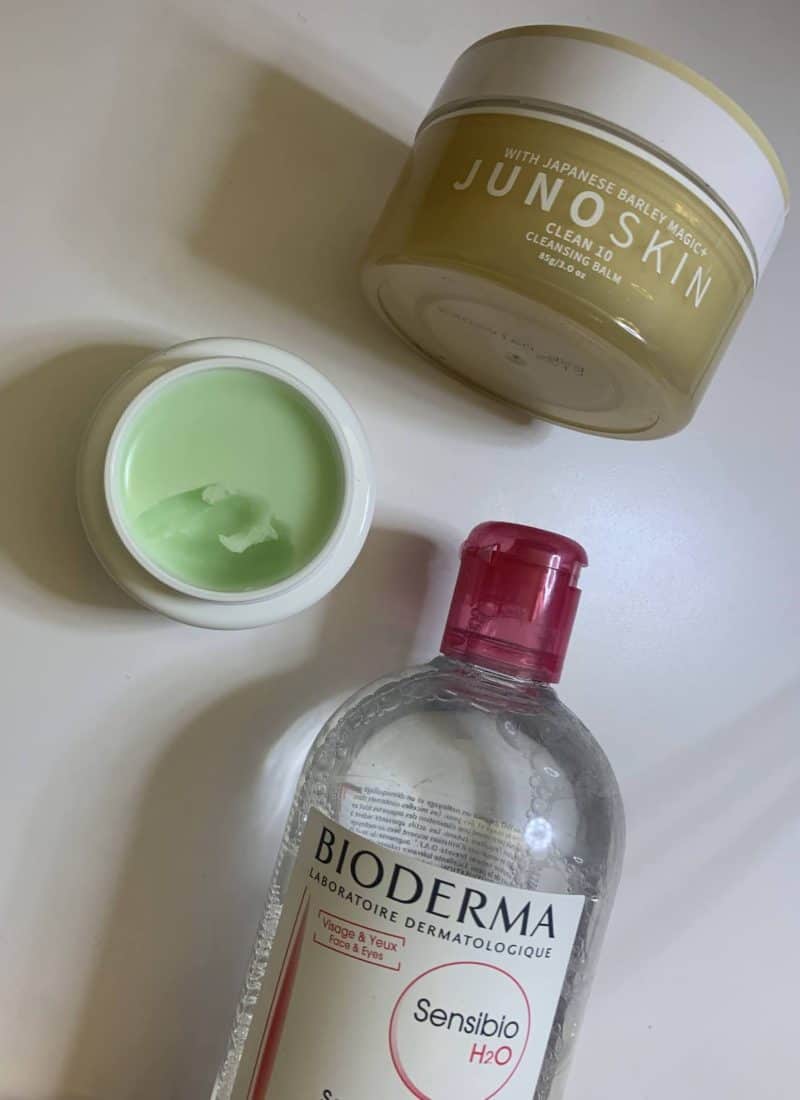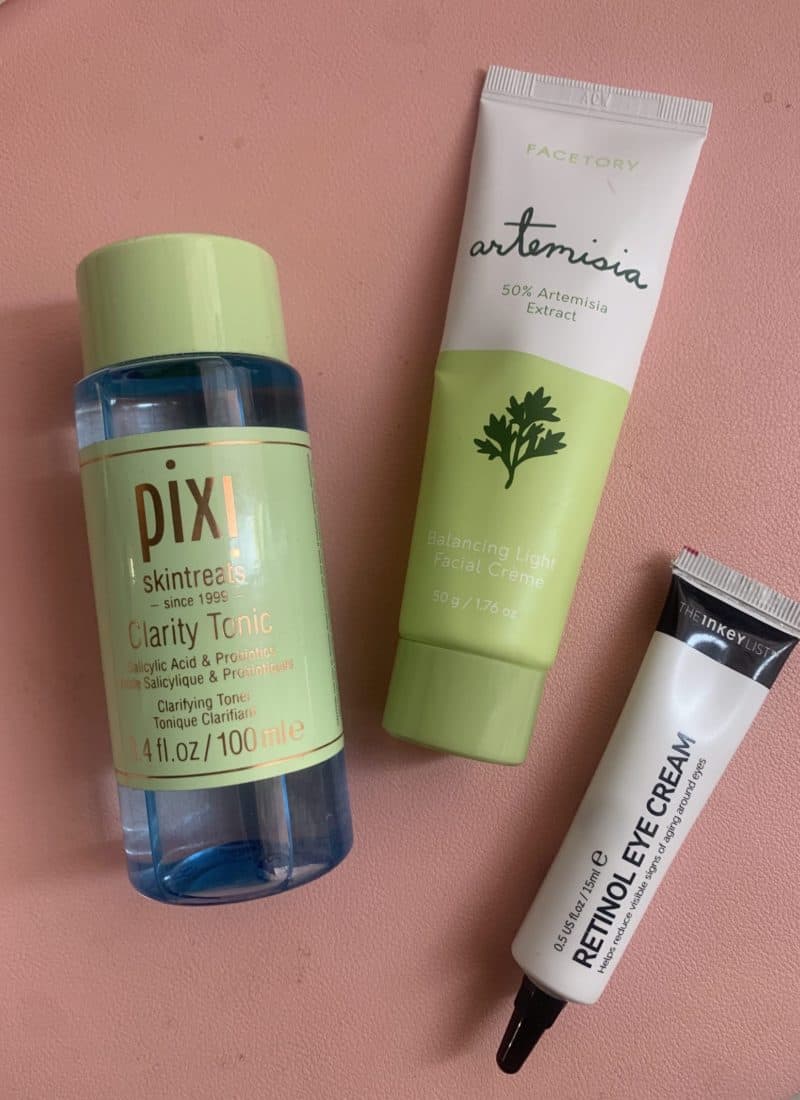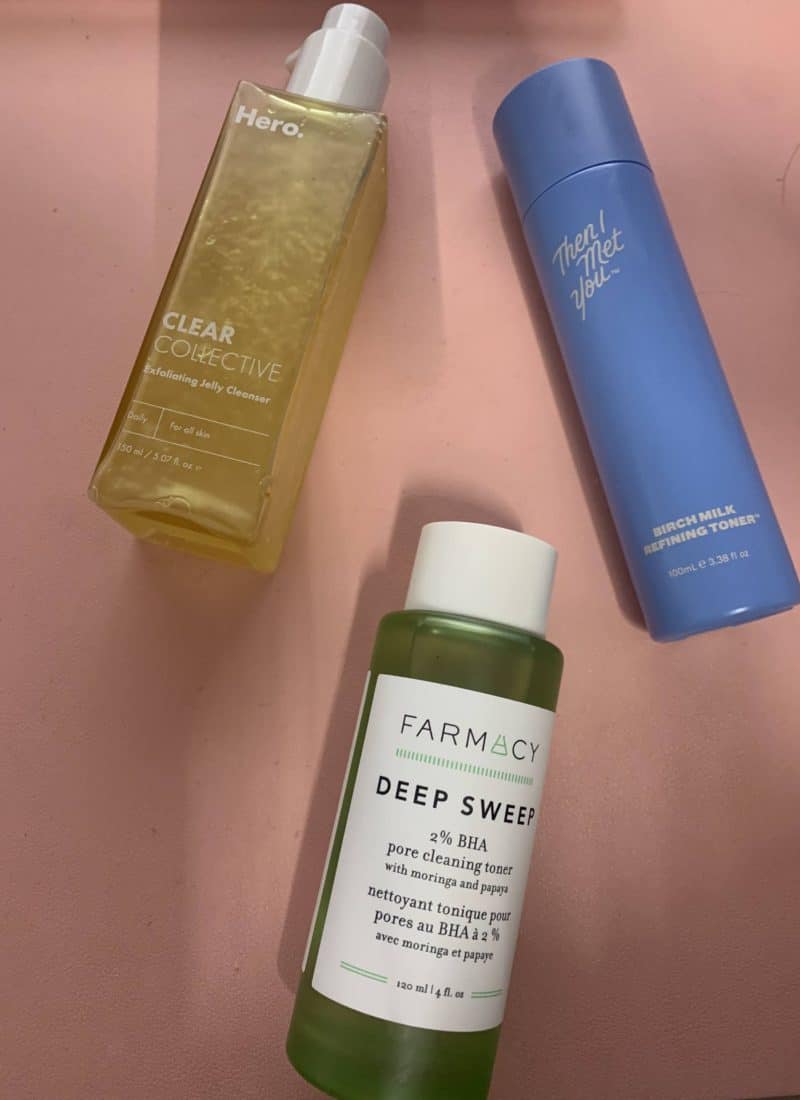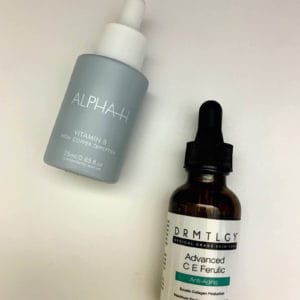When talking about exfoliating skin care, many people’s first thought is a face scrub. But there are actually two main types of exfoliation: physical and chemical exfoliation. While they each have their place, there are a lot of differences between the two. Today I’m going to talk about the difference between physical vs chemical exfoliation and what you should be looking for. Exfoliation isn’t a necessity in a skin care routine, but if you’re dealing with acne, clogged pores, fine lines, uneven skin texture, or another skin concern, they’re a great addition.
Physical Exfoliation
Physical exfoliators are typically what people think of when they hear “exfoliator.” Face scrubs, face brushes, and any type of scrub bead are considered physical exfoliators. These methods of exfoliation work on the top layer of the skin to help with dead skin cell removal from the surface of the skin. Personally, I find physical exfoliators extremely satisfying because they provide “instant gratification.” However, it’s really easy to overdo it with scrubs and face brushes and cause excess irritation and sensitivity. Irritated skin can lead to a damaged skin barrier and sensitive skin. In fact, I’d recommend avoiding physical exfoliation if you have active acne. The abrasiveness of scrubs can actually make acne worse.
Face Scrubs
Remember the St. Ives scandal? It’s difficult to make walnut shells (and a lot of other physical scrub beads) perfectly circular. Having jagged edges can actually cause microtears in the skin which damages your skin in the long run. I’ll be honest, there’s something very satisfying about a physical scrub, but I’d recommend going for a gentler option like rice enzymes or skincare scrubs with finer scrub beads like jojoba beads. A physical exfoliator isn’t inherently bad, but it’s important to be gentle when using them. I’d recommend limiting use of a physical exfoliant to 1 or 2 times a week.
Product Recommendations:
Cleansing Devices
Let’s move onto cleansing devices like Clarisonic, Foreo, sponges, or scrub bushes. In general, these can help give the skin a deeper clean, but they’re definitely not a necessity. I do enjoy using my Foreo once or twice a week when I feel like my skin needs a deeper clean. However, you can get a thorough cleanse with just your hands. If you decide you’d like to use one of these cleansing devices, I wouldn’t recommend using them any more than 2 or 3 times a week. Gentler is better when it comes to exfoliation, so remember to minimize use to just a few times a week.
Product Recommendations:
- Foreo Luna Fofo (I don’t find the other models to be worth the additional money)
Chemical Exfoliation
Now let’s talk about picking a chemical exfoliant. These typically use exfoliating acids like alpha hydroxy acids, beta hydroxy acids, or poly hydroxy acids (AHAs, BHAs, PHAs).
Alpha-Hydroxy Acids
AHAs are water-soluble exfoliating acids that work by breaking down the “glue” between the dead skin cells on your skin. This helps to remove these dead skin cells from the skin’s surface to help with dull skin. AHAs help to increase your skin’s cell turnover rate (how quickly it sheds dead skin cells). This can help improve uneven skin tone/texture, hyperpigmentation, and loss of firmness. There are many different alpha hydroxy acids used on the market, but here are some of the popular ones:
Types of Alpha-Hydroxy Acids:
Glycolic Acid: An alpha hydroxy acid derived from sugar cane. It has the smallest molecule size of the AHAs, meaning it can easily penetrate your skin. This is great for seeing results quickly, but it can be irritating for more sensitive skin types. Can help with signs of sun damage and improve skin cell turnover.
- Product Recommendations:
Lactic Acid: An AHA originally derived from sour milk. Lactic acid actually helps improve hydration in the skin, making it a great option for dry skin. It also has a larger molecule size than glycolic acid, so it’s a bit more gentle on the skin.
- Product Recommendations:
- Sunday Riley Good Genes
- Biossance Squalane + Lactic Acid Serum
- Isntree AHA 8% Serum (Lactic + Glycolic Acids)
Mandelic Acid: An AHA derived from bitter almonds. It’s one of the most gentle AHAs due to its large molecule size. Mandelic acid is a great option for sensitive skin or combination skin that can’t tolerate glycolic or lactic acids.
- Product Recommendations:
Tartaric Acid: An AHA derived from plants. It’s not as commonly used as the other three above, but it doubles as an antioxidant + exfoliating acid! Since it’s gentler on the skin, it’s often used in combination with other AHAs to minimize irritation.
Malic Acid: An AHA derived from apples. Similar to tartaric acid, this isn’t as commonly used but can be found in combination with other exfoliating acids. Malic Acid can also act as a humectant, making it another great option for drier skin types.
- Product Recommendations:
- Renee Rouleau Triple Berry Smoothing Peel (A chemical peel with Lactic, Salicylic, Malic, Mandelic, and Tartaric Acids)
Citric Acid: An AHA derived from citrus fruits. Citric acid is most commonly used in skincare products to help adjust the pH of the formula. However, some brands also use it as a mild AHA in their products. This provides gentle exfoliation when used in small percentages.
When it comes to picking between these AHAs, I recommend starting with a gentler exfoliating acid like mandelic acid. Then, you can try a different acid like lactic or glycolic depending on your skin type and tolerance. It’s all about finding a chemical exfoliator that works for you and your skincare routine.
Beta-Hydroxy Acids
BHAs are oil-soluble exfoliating acids that can penetrate deeper into the pore to remove excess oil and sebum. These are a great option for oily and congestion prone skin, which is why brands use these in many acne-fighting products.
Salicylic Acid is the most commonly used, but willow bark extract and betaine salicylate are sometimes called BHAs. These two are derivatives of salicylic acid, but are not as effective as true salicylic acid. Willow bark extract can help with balancing oiliness, but it doesn’t have as strong of exfoliating properties as salicylic acid. Betaine salicylate is one step stronger than willow bark extract, but it’s a good BHA exfoliant for sensitive skin types that can’t handle salicylic acid.
Salicylic Acid is a beta hydroxy acid that is regulated as a drug by the FDA to treat acne. Salicylic Acid is pretty well-tolerated and is typically gentle on the skin. However, since salicylic acid is oil-soluble, it can be drying for drier skin types. If you have oily skin or acne prone skin, salicylic acid is a great option. It can also help with blackheads and clogged pores.
- Product Recommendations:
- Benton Deep Green Tea Serum (Willow Bark Extract)
- CosRx BHA Blackhead Power Liquid (Betaine Salicylate)
- The Inkey List Salicylic Acid Cleanser (Salicylic Acid)
- Farmacy Deep Sweep (Salicylic Acid)
- Sunday Riley UFO (Salicylic Acid)
Poly-Hydroxy Acids
PHAs are the gentler cousins to AHAs. They are very gentle on the skin and work similarly to AHAs. PHAs typically have very large molecule sizes, making them less irritating than other acids. They’re growing in popularity in the skincare market as a gentle exfoliating option for sensitive skin. There are two main types of PHAs:
Gluconolactone: The most commonly used PHA. Gluconolactone acts as a humectant, making it a great option for dry skin. It can help even out skin tone/texture and is a great option if you experience skin sensitivity with AHAs.
Lactobionic Acid: A PHA derived from milk. Lactobionic acid has a large molecule size that makes it very gentle on the skin. It also acts as an antioxidant and is another solid option for sensitive skin types.
- Product Recommendations:
- Then I Met You Birch Milk Refining Toner (Glycolic Acid, Lactic Acid, and Gluconolactone)
- Glow Recipe Watermelon PHA + BHA Toner (Gluconolactone, Betaine Salicylate, and Willow Bark)
Physical vs Chemical Exfoliation: Which is better?
When it comes to deciding between physical vs. chemical exfoliation, I (and most derms) say chemical exfoliators reign supreme. I totally get that a good face scrub is satisfying, but they only exfoliate the surface of the skin. Chemical exfoliators, on the other hand, work deeper to help remove dead skin cells and improve cell turnover. It’s also very easy to overdo it when using exfoliants. Chemical exfoliators are more effective and can be much more gentle in comparison!
On top of that, chemical exfoliators can treat more skin concerns effectively. If you’re dealing with mild acne, uneven skin tone/texture, and hyperpigmentation, chemical exfoliation will be your BFF. Physical exfoliation is limiting because it only works on the surface and can really only help with uneven skin texture.
However, you don’t have to say goodbye to your face scrub forever. I’d recommend prioritizing chemical exfoliation over physical exfoliation first in your skin care routine. Once your skin is accustomed to using chemical exfoliators regularly, you can consider incorporating a facial scrub once a week. Regardless of which type of exfoliator you choose, I’d recommend only using it 2-3 times a week to avoid over-exfoliation.
What are your favorite ways to exfoliate your skin?
Product links are affiliate links. I do earn a small commission if you purchase from these links (with no additional cost to you), which supports me and my blog. Feel free to check out all of my affiliate/referral links or shop my favorites if you decide to shop. Thank you for your support!



